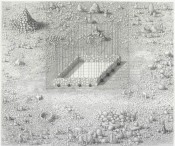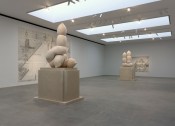w-e-l-c-o-m-e-t-o-n-o-b-s-o-n, announce the capital letters in the fifteen-part drawing, dated 2010, that prefaced Paul Noble’s first UK solo show since the Whitechapel Gallery’s 2004 survey. But shouldn’t that have been “welcome back”? Noble’s instantly recognizable, manically detailed pencil-on-paper drawings have mapped the dystopia of Nobson for some fifteen years now, and one feels one’s been welcomed to it on several previous occasions. However, despite Nobson’s apparent spatial coherence—its navigable if wonky perspectives and its distinctive architectures formed of quasi-legible text—it is not best thought of as a place one can arrive at or return to; critical accounts that fall in step with the artist’s conceit and mimic travelogues arguably mistake the map for the territory. Deep down, Nobson is less a socio-geographical allegory than a creative constraint in a vaguely Oulipian sense, and (like the mysterious “Art Machine” algorithm that supposedly dictated Keith Tyson’s early work, or the painterly appropriations of Glenn Brown) it’s one that issues in existential doubt and crisis.
The letters in w-e-l-c-o-m-e-t-o-n-o-b-s-o-n are depicted in typical Noble style as awkward architectonic blocks and decorated, as if in relief, with a perverse reworking of the Genesis story. Nobson’s God busies himself as per the Bible, separating light from darkness, creating the wind (by farting, natch), and fashioning each Nobsonian in his own image as a kind of tripartite maggot or turd, with head, thorax and abdomen, each end enhanced with faintly condom-like points.
These images are effectively preparatory sketches for Welcome to Nobson, 2008–10, the vast multi-paneled drawing that dominates Gagosian’s main gallery. In this piece the letters are stacked up, totem-like, in a kind of park bounded by an impossibly fragile-looking, ornate fence. Around this perimeter are groves of delicate, tree-like fountains pumping out turdlike dollops of matter. Elsewhere, bulging, sagging garbage bags litter the landscape or adorn strangely fangled pieces of civic furniture.
Two monumental sculptures made from Band-Aid-pink Rosa Portugal marble also loomed large. Couple, 2011, represents two blobby Nobsonians, one sitting on the other’s lap: a Pietà, maybe? In Three, 2011, one figure serves as seating for two others. The marble’s veining, running vertically down the lumpy forms, suggests the mold seams of, say, a cast plastic object, visually debasing both the luxuriousness of the stone and the sculptures’ good-taste formal allusions to Moore and English modernism. Further, the arrangement of Three suggests a Sadeian scenario: sexuality systematized and enacted on a production-line basis. Noble’s persistent undercutting of humanistic, high-cultural reference with anti-humanist imagery feeds back into the creation theme set up at the show’s start. With ruthless persistence, creation is conflated with defecation and entropic decay. In another drawing, Family is Infinity (or, Hard Labour), 2009–10, one of Noble’s hallmark rectangular enclosures is shown adrift in a desert of hundreds of tiny, painstakingly drawn stones. Vija Celmins’s desert drawings come to mind, but Noble’s cartoonish stones gloss process art’s intellectual claims with an abject, absurd purposelessness. Drawing becomes a surrender to entropy, a business of dirtying the page. The precarious little cairns that scatter the desert floor testify to the pathos of fantasies about production as transcendence; like their makers, they will soon vanish. Some critics prefer to read Noble’s project as an assertion of art’s power to lend meaning to an indifferent universe, but he gives ample grounds to make the call the other way. And paradoxically, it is its capacity to open up, vertiginously, onto an abyss of sheer existential meaninglessness that gives the work its weight.
Paul Noble: Welcome to Nobson showed at Gagosian, London, between November 10 – December 17 2011
Text © Rachel Withers & Artforum International Magazine, Inc. 2011. Images © Paul Noble, Gagosian Gallery and others: contact Gagosian Gallery for details.

